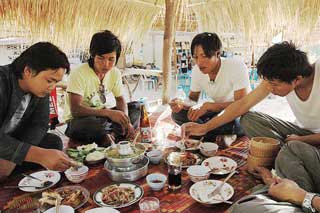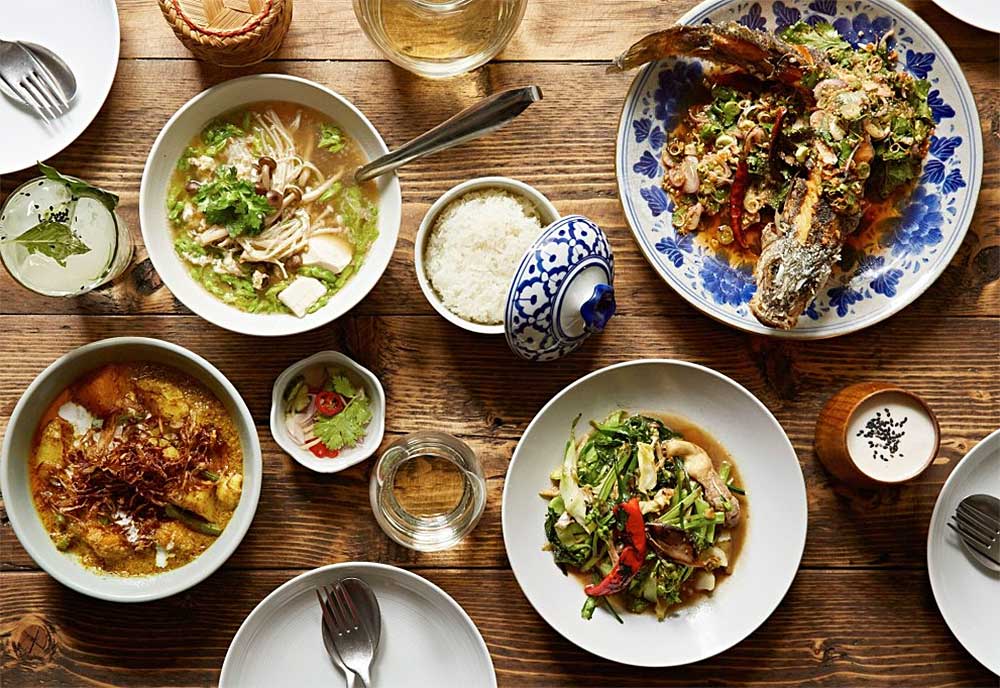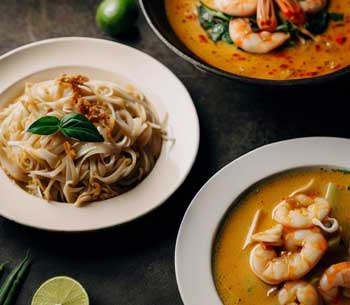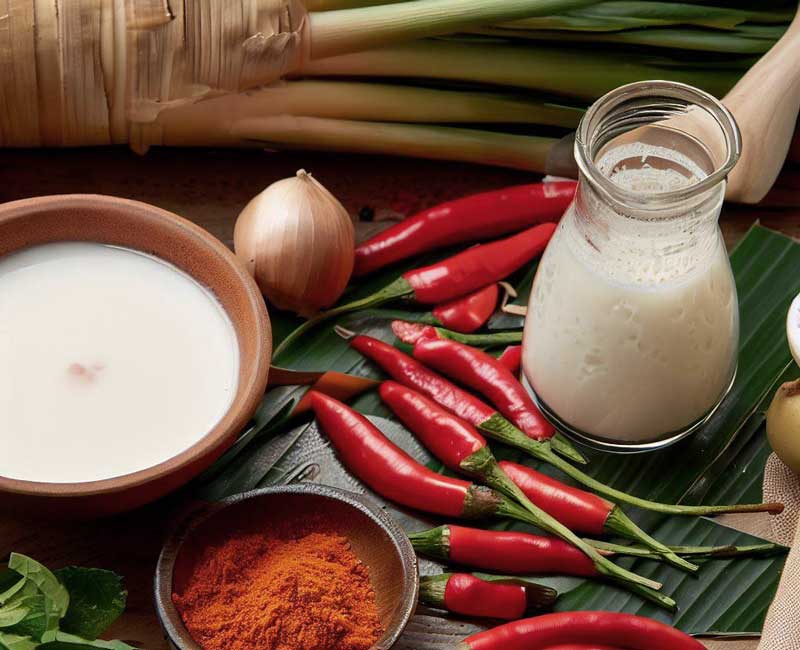What is Thai Food Exactly?
The question might seem basic to many, but it’s a reminder that Thailand, a small Southeast Asian country, isn’t well-known to everyone.
Not everyone has heard about Thailand or its delicious cuisine. In a world filled with information, some might miss the chance to learn about the rich culture and amazing food this country offers. Thai cuisine, with its mix of flavours, could remain unexplored by those who haven’t encountered it before.
Don’t worry though because here we are going to cover everything about Thai food for beginners.

The Basics of Thai Food
Thai food is a vibrant and flavorful cuisine originating from Thailand. It’s characterized by a harmonious balance of sweet, sour, spicy, and salty flavours in every dish.
Essential ingredients include aromatic herbs like lemongrass and kaffir lime leaves, chilli peppers for heat, fish sauce for umami, and coconut milk for richness.
Popular dishes include Pad Thai, Tom Yum Soup, and Green Curry. Thai cooking techniques comprise of stir-frying, steaming, grilling, and boiling.
Thai cuisine reflects a rich cultural heritage, creating a delightful blend of tastes that has captivated palates worldwide.
Common Ingredients in Thai Food
For people new to Thai food, some of the flavours can be quite overwhelming. Beginners often wonder how it’s possible to create such amazingly tasty food. The secret is in the handful of key ingredients that create the exquisite balance of sweet, sour, spicy, and salty tastes.
For beginners, these are the fundamental components, treasured for centuries, that form the essence of Thai food.
Chili Peppers: Central to Thai cuisine’s fiery personality, chilli peppers bring both heat and depth to dishes. Their diverse range caters to varying palates, from the mild warmth of bird’s eye chillies to the intense spiciness of Thai bird chillies.
Lemongrass: With its citrusy fragrance and delicate flavour, lemongrass is a culinary cornerstone. It imparts a zesty, refreshing note to soups, curries, and marinades.
Galangal: Resembling ginger, yet with a peppery and pine-like aroma, galangal adds complexity and depth to Thai cuisine. It’s a staple in curry pastes and soups.
Kaffir Lime Leaves: These aromatic leaves bring an intense citrus aroma to dishes. They’re commonly used in soups, curries, and stir-fries, infusing a unique fragrance.
Fish Sauce: Often referred to as the “umami bomb” of Thai cooking, fish sauce is a fermented condiment made from fish and salt. It provides a savoury depth and complexity to a myriad of dishes.
Coconut Milk: A creamy elixir derived from the white flesh of coconuts, coconut milk brings a luxurious richness to Thai curries, soups, and desserts, countering the spiciness with a soothing touch.
Thai Basil: Unlike its sweet Italian counterpart, Thai basil boasts a distinctive aroma with an anise-like undertone. It’s a common herb in stir-fries, curries, and noodle dishes.
Palm Sugar: Derived from the sap of palm trees, palm sugar is used to add sweetness and depth to Thai dishes, balancing the flavours and harmonizing the taste profile.
Tamarind: This tangy fruit lends its sour notes to Thai cuisine. Tamarind pulp is used to create the sour base of many dishes, contributing to the vibrant flavour profile.
Shrimp Paste: A potent umami-packed condiment made from fermented shrimp, it’s often used as a foundational ingredient in curry pastes.
These key ingredients weave together the intricate tapestry of Thai cuisine, creating a symphony of flavours that are simultaneously bold and harmonious. Whether in street food stalls or fine dining establishments, these elements remain the backbone of Thai cooking, enchanting diners with every bite.
The 10 Most Popular Thai Foods for Beginners
If you’re new to Thai cuisine, exploring these 10 common dishes is a great starting point to experience the rich flavours and diverse range of Thai food:
Pad Thai: A beloved stir-fried noodle dish with eggs, tofu, and your choice of protein, tossed in a tamarind-based sauce and garnished with crushed peanuts and lime.
Tom Yum Goong: A hot and sour shrimp soup, featuring fragrant lemongrass, galangal, and kaffir lime leaves, with a burst of chilli heat and tangy lime.
Green Curry (Gaeng Keow Wan): A creamy coconut-based curry with tender chunks of chicken, beef, or vegetables, infused with the flavours of green chilli paste, Thai basil, and aromatics.
Massaman Curry: A mild yet rich curry with influences from Persian cuisine, combining tender meat (usually beef or chicken) with potatoes and peanuts in a flavorful spiced sauce.
Som Tum (Papaya Salad): A refreshing salad made from shredded green papaya, tomatoes, green beans, peanuts, and chilli peppers, all tossed in a tangy lime dressing.
Pad See Ew: Wide rice noodles stir-fried with dark soy sauce, Chinese broccoli, and your choice of protein, resulting in a savoury and slightly sweet dish.
Khao Pad (Fried Rice): Fragrant jasmine rice stir-fried with a medley of vegetables, protein, and egg, often seasoned with soy sauce and served with a wedge of lime.
Panang Curry: A rich and aromatic red curry that’s less spicy than some others, featuring tender meat (chicken, beef, or pork) in a creamy coconut sauce.
Pad Krapow (Basil Stir-Fry): A quick and flavorful stir-fry dish made with minced meat (often pork or chicken), Thai holy basil, garlic, and chilli peppers, served over rice and topped with a fried egg.
Tom Kha Gai: A creamy and soothing coconut milk soup with chicken, flavoured with galangal, lemongrass, and kaffir lime leaves, and gently spiced with Thai chillies.
These dishes offer a well-rounded introduction to Thai cuisine, showcasing its distinctive blend of flavours and culinary techniques. As you explore these beginner-friendly options, you’ll gain a deeper appreciation for the intricacies and deliciousness that Thai food has to offer.
Restaurants – How to Order Thai Food for Beginners
Ordering Thai food in a restaurant can seem like a daunting task if you are a noobie. As a beginner, understanding some basic Thai food etiquette can enhance your experience and help you navigate the menu with confidence.
Consider Spice Levels:
Spice Tolerance: If you’re not accustomed to spiciness, don’t hesitate to request a milder version of a dish. Thai restaurants often accommodate varying spice preferences. Most menus in Thai restaurants will give you a warning if a specific dish is very hot.
Sharing Culture:
Unlike Western food, Thai food, on the whole, is made to be shared. Everything on the table is supposed to be eaten with rice. In fact, it’s safe to say that rice is the single most important component of the meal.

Generally, each person will have their own plate of rice which is accompanied by several shared dishes which often include a curry, a fish dish, a stir-fry, salad, soup and vegetables.
All the food is served at once so there are no starters. Soups come in a large bowl and are eaten with the meal, not before it. The flavours of each dish are stronger than what you would expect because they’re made to be eaten with rice.
Dining Manners:
In Thai culture, chopsticks are primarily used for noodle dishes, while spoons are used for rice and curries. You’ll often find both utensils on the table.
As mentioned before, shared dishes are placed in the centre of the table for everyone to share. Do not use your own spoon or fork to take food from the communal plates as this is considered bad form. Each communal dish should have its own spoon or fork.
Condiments:
Most Thai restaurants provide condiments like fish sauce, chilli flakes, and sugar. Use them to customize the flavour of your dishes according to your preference.
Basic Vocabulary:
If you have a Thai waiter, here are some basic words you could try and use 🙂
| English | Thai Transliteration | Thai Script |
|---|---|---|
| Delicious | Aroi | อร่อย |
| Spicy | Ped | เผ็ด |
| Not Spicy | Mai ped | ไม่เผ็ด |
| Water | Nam | น้ำ |
| Rice | Khao | ข้าว |
| Noodles | Sen | เส้น |
| Chicken | Gai | ไก่ |
| Pork | Moo | หมู |
| Beef | Neua | เนื้อ |
| Shrimp | Goong | กุ้ง |
| Fish | Pla | ปลา |
| Tofu | Tao-hu | เต้าหู้ |
Is Thai Food Healthy?
Thai food is so diverse and covers so many different things, in general though, is Thai Food healthy? No, it’s not particularly healthy or unhealthy. Just like cuisines from any country, there are good and bad points.
In general, most Thai food contains sugar. This is definitely not healthy. Also, many things are deep-fried.
On the other hand, there are lots of Thai vegetable soups which contain hardly any calories at all. Also, Thai food contains lots of healthy nutritious herbs and spices like galangal, Thai holy basil, turmeric and lemongrass.
Coconut milk is often used in Thai food, especially in curries and soups. The health benefits of coconut milk are widely recognized.
To learn more on this subject, check out my other post entitled ‘is Thai food healthy‘.





No Longer a Beginner
If you’ve got this far then you’re no longer a beginner. You’ve learned a lot about Thai food already and now you can continue your journey. Check at the bottom of the page for more related posts. 🙂
Please Leave a Rating If You Enjoyed This Post 🙂




